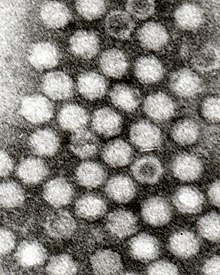Dependoparvovirus
| Dependoparvovirus | |
|---|---|

| |
| Virus classification | |
| (unranked): | Virus |
| Realm: | Monodnaviria |
| Kingdom: | Shotokuvirae |
| Phylum: | Cossaviricota |
| Class: | Quintoviricetes |
| Order: | Piccovirales |
| Family: | Parvoviridae |
| Subfamily: | Parvovirinae |
| Genus: | Dependoparvovirus |
| Species | |
|
See text | |
Dependoparvovirus (formerly Dependovirus or Adeno-associated virus group) is a genus in the subfamily Parvovirinae of the virus family Parvoviridae;[1][2] they are Group II viruses according to the Baltimore classification. Some dependoparvoviruses are also known as adeno-associated viruses because they cannot replicate productively in their host cell without the cell being coinfected by a helper virus such as an adenovirus, a herpesvirus, or a vaccinia virus.
Species
There are eleven recognized species:[3]
- Adeno-associated dependoparvovirus A
- Adeno-associated dependoparvovirus B
- Anseriform dependoparvovirus 1
- Avian dependoparvovirus 1
- Carnivore dependoparvovirus 1
- Chiropteran dependoparvovirus 1
- Pinniped dependoparvovirus 1
- Rodent dependoparvovirus 1
- Rodent dependoparvovirus 2
- Squamate dependoparvovirus 1
- Squamate dependoparvovirus 2
Virology

Dependoparvoviruses have an
The genome is a single molecule of single stranded DNA with a length of 4.7 kilobases. It has only two open reading frames. The 3' open reading frame is the structural capsid protein, cap, which can be spliced to form two RNAs, one for virion protein 1 (VP1) and the other goes on to eventually make VP2 and VP3. The second gene, rep, can be spliced into four different, nonstructural, regulatory proteins that all aid in the genome replication. These proteins are named Rep 78, Rep68, Rep 52, and Rep 40 based on their molecular weight.[4]
Due to inverted terminal repeats (ITRs) at each end of the genome, a T-shaped
Host range
These viruses are capable of replication within all vertebrates. They are only limited by the virus they must infect with, also known as the helper virus. These helper viruses are necessary for the replication of a dependoparvovirus. A common helper virus in humans is the
Gene therapy
Dependoparvovirus is not infectious enough to trigger an
At this time, one challenge using this virus as a therapy tool is the fact that the genome is fairly small. With less than 5kb in the genome the amount of genetic material that can fit into the capsid is limited. Work is currently being done to increase the amount of information this vector can deliver. This may be accomplished by the ITRs found at both the 5' and 3' end of the genome. Since the ITRs have the same sequence they will leave complementary strands exposed if they are removed. The complementary strands can undergo recombination and join two 5kb inserted fragments together.[7]
References
- PMID 30672729.
- ^ "ICTV 10th Report (2018)".
- ^ "Virus Taxonomy: 2020 Release". International Committee on Taxonomy of Viruses (ICTV). March 2021. Retrieved 10 May 2021.
- ^ PMID 15877812.
- ^ a b ICTVdB Management (2006). Büchen- Osmond, C. (ed.). "ICTVdB - The Universal Virus Database, version 4: Dependovirus". Columbia University, New York, US. Retrieved 4 May 2009.
- PMID 19237554.
- PMID 17984978.
